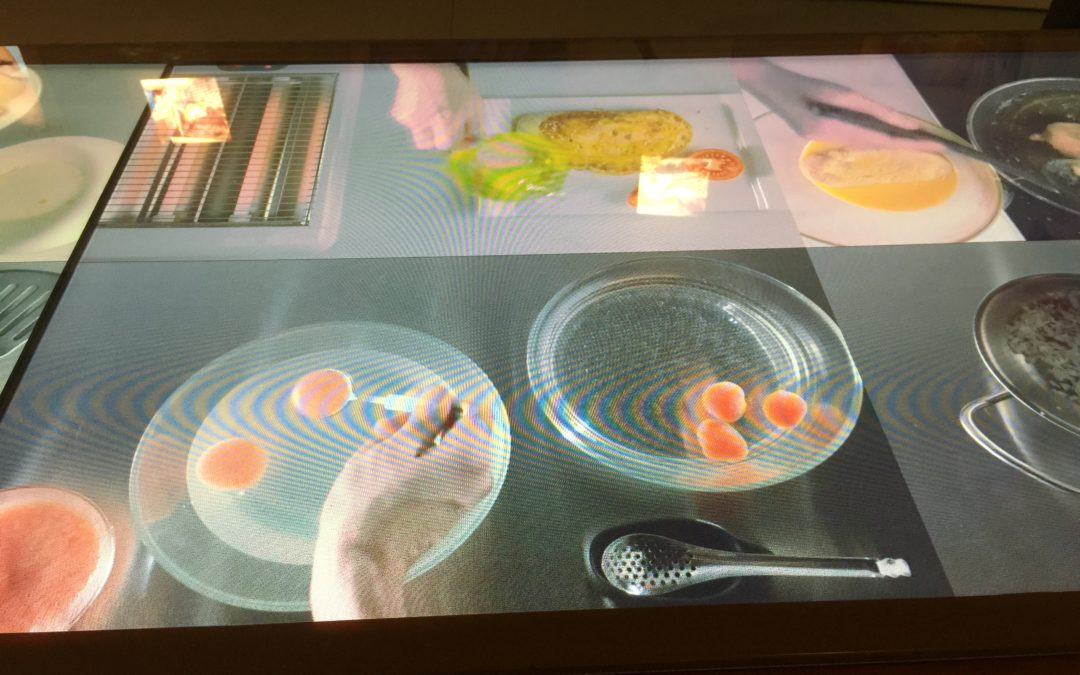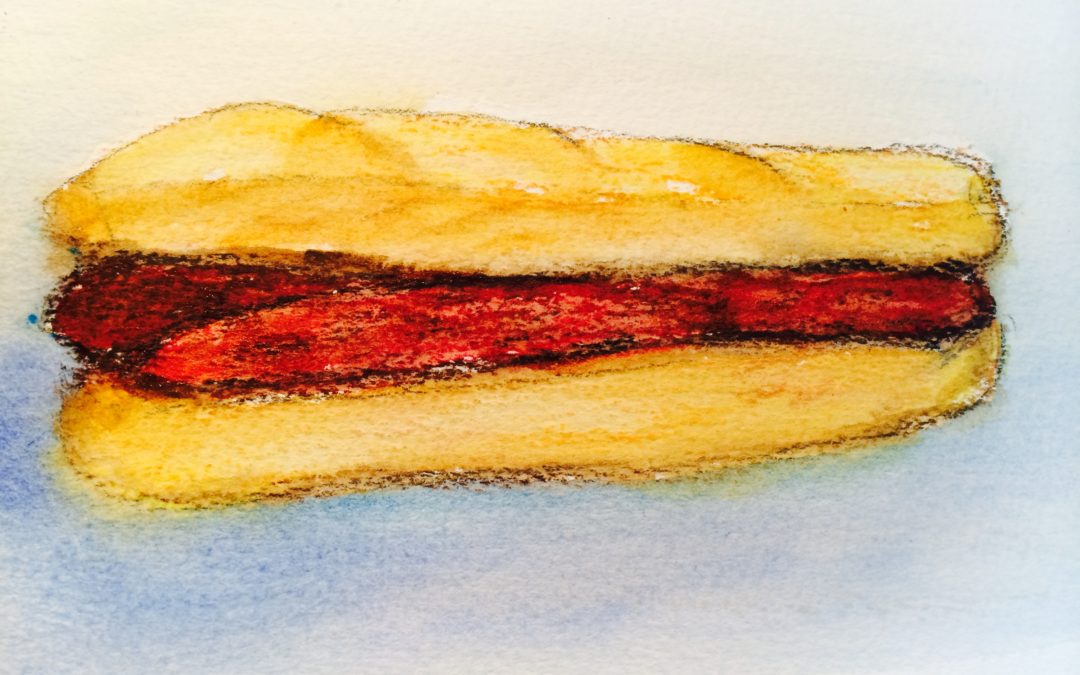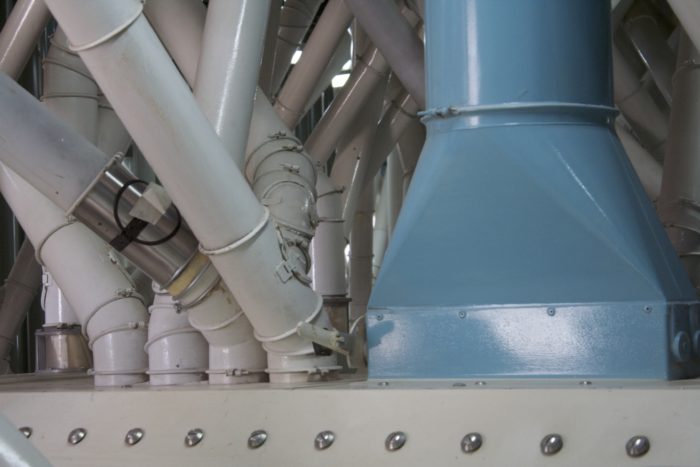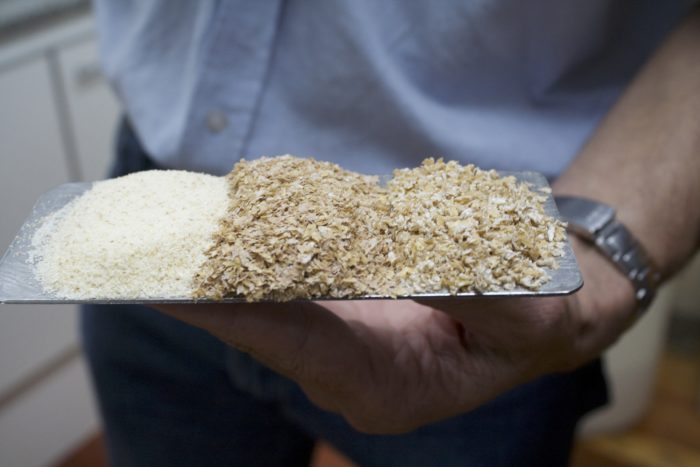
by Food+City | Jul 24, 2015 | Food Tracks Blog, History, Stories
George Huntington Hartford and George Gilman, 19th century entrepreneurs, would flinch at this week’s news that the A & P grocery store chain was filing for bankruptcy. The two Georges created the iconic grocery chain in 1859 and built what we now know as the grocery supermarket. They developed the model for grocery stores that sell low-priced food across the U.S. Now, for the second time in ten years, the beleaguered company has less than 300 stores, down from the 16,000 it operated in 1929. The demise of A & P, the oldest supermarket chain, may be the beginning of the end of the big box, super-sized grocery chains.
Similar to the grocery industry, other economic institutions and industries — banks, taxi services, healthcare, and the hospitality industry — are experiencing “creative disruption.” And food distribution is ripe for repair. The local, personal, and transparent is colliding with accessibility, price, and quality. George Hartford and George Gilman, founders of The Great Atlantic and Pacific Tea Company, led the first wave of destruction by putting thousands of corner grocery stores out of business at the beginning of the 20th century, and now the effective equivalent of small and local distribution centers may be our future food distribution system.
Marc Levinson’s book, The Great A & P and the Struggle for Small Business in America (2011), tells the story of the rise of big grocery chains from the 1920s until the present day — and how A & P became the world’s largest grocery store chain. Levinson tells us how A & P innovated its way to success only to be come under attack for practices that benefited middle-class consumers by making low cost food accessible. A & P couldn’t find a way to re-create itself amidst pressures from low-priced competitors such as Wal-Mart and high-end stores such as Whole Foods.
By the 1950s the company began a long decline into bankruptcy, unable to resuscitate itself after the onslaught of regulations, attacks, competition, and the loss of its founding team. By building a new aggregated, or “combination store,” as the first supermarkets were called, Hartford and Gilman created often aggressive and innovative ways to bring down the cost of food. Buying directly from food producers instead of wholesales, A & P created some of the first discounted grocery stores. They vertically integrated some activities, such as baking their own bread. They contracted directly with farmers who grew crops specifically for A & P and developed recycling systems for packing materials. The consequence of the new A & P model was the demise of the mom-and-pop grocery store in the early 1920s.
These new approaches to food retailing benefited from the appearance of new technologies that directly improved access to food at lower costs. The first commercial refrigeration systems replaced huge blocks of ice and enabled A & P to hold more inventory. Shoppers could buy enough food for one week without returning for perishable meats and poultry on a daily basis. Open access to food products eliminated the need for a shopkeeper, lowering the store’s operating costs. And when cellophane was developed in France in 1909, the new transparent wrapping material made it possible for consumers to see the food they purchased, a development that increased consumer confidence in food safety.
A & P’s new model encountered feisty competitors and the ire of unions and wholesalers. They fought alongside politicians to push against the growth of the supermarket, joining politicians, journalists and industry associations that accused the brothers of “unfair completion.” The excesses of the Gilded Age and poverty left behind in the wake of the stock market crash in 1929 placed big business in the political crosshairs. Franklin Roosevelt, running on his Progressive ticket, set up regulations, oversight agencies, and rules that threatened the competitive advantages of A & P. Roosevelt called the company a “gigantic blood sucker.”
Accusations of “unfair competition” threaten today’s startups. Taxi cab drivers in both Massachusetts and California are among the many threatened by new economies. Taxi companies have united to sue Uber for “unfair competition.” Ironically, unions are cited by A & P as a significant reason for its bankruptcy filing. A & P officers say that union demands for benefit increases are key to the company’s inability to cut operating costs.
But the accusation of unfair competition raises questions about our current economic landscape. Companies have new competitors, often outside of their traditional industry. Wal-Mart competes with Amazon. And Wal-Mart may be competing with itself. Charles Fishman’s 2006 book, The Wal-Mart Effect (How an Out-of-Town Superstore Became A Global Superpower) suggests that Wal-Mart is so big that their practices are no longer unfairly competitive. Rather, the company is so big that it creates its own market forces. Other big supermarket chains, including Kroger and Costco, both cut their costs to compete with Wal-Mart to offer consumers lower prices.
The tension between Big Box grocery chains and small, independent food retailers continues today, fought with digital weapons and by new players, such as Amazon and Instacart. Signs of the disruption of the grocery industry are apparent across several sectors, from UPS to Google. The re-imagined grocery story is taking shape as a response to the newly food-aware customer who searches for healthy food from a transparent, hopefully human or human-like provider. And the landscape for food distribution may look very different in ten years, populated by Amazon, public food lockers, and encapsulated meals. Amazons’ “buy” button brings customers closer than ever before to a virtual warehouse. And the FAA released regulations for drone tests, the mini-aero service.
Hartford and Gilman’s legacy of supermarkets and low-priced food may continue to be with us but in a new incarnation, more as an aggregated virtual supermarket that utilizes high-tech, “last mile” delivery options. Let’s hope that our future food distribution system will continue to provide better food to more people at low prices. And maybe A & P will re-emerge, making George Hartford and George Gilman proud again.

by Food+City | Jul 17, 2015 | Food Tracks Blog, Stories
While “thought leaders” gather around the world to predict the future of food, Italians are hosting this year’s world’s fair, the Milan Expo 2015. The Italians are using the Expo to burnish its brand as the preeminent leader of food innovation. The Italians came up with the Maserati and the Moka pot, so why not edible packaging and digital delivery of food?

But wait, what happened to French leadership in all things food-related? If you attend the Milan Expo, you’ll be hard pressed to see where France fits in. Of course, since Italy is the host of the fair, the affair has an effusive Italian feel. Eataly has a large footprint, as does espresso, gelato, and pasta. And in almost every detail, from the kiosks to the drinking fountains, you can see the fingerprints of Italian designers.
Nations have used these fairs as a platform for nation-branding, so it’s no surprise that Italy emerges as the new leader of food design, taste, and innovation. No telling what the French will need to do to regain their preeminent position as the arbiter of food. Although a group of young chefs in Paris is rallying the new generation of French chefs, they will have to imagine how to regain the crown for leadership of all things food-related now that chefs in other countries have moved ahead without being tied to a stubborn French narcissism. And, in addition to the new generation of French chefs, French entrepreneurs are finding opportunities to regain their high regard for a blend of art and science in food. This summer, 33entrepreneurs, a French startup accelerator in Bordeaux, France, will be traveling throughout the US with its tour of food startup contests in the areas of food, beverages, wine, and travel. (The organization’s use of “33” comes from its goal of “disrupting the way 33% of the world’s GDP.”) Perhaps these young startups will put France back in the game.
After all, the French launched the world’s first industrial exposition in 1798, in Paris, and established France, in particular Paris, as the leader in food and fashion. Everyone, including the English, attended these events, enjoying food created by French chefs and delighting the French flair for fashion. The French expositions were really a display of how technology and art merged to make useful innovations. In 1885, Jules Burlat described the 1844 fair, noting how industrial art and fine art shared the stage. Almost 4,000 exhibitors crowded the pavilions during the 1844 world’s fair in Paris, displaying the latest inventions in industry and agriculture. Steam was the biggest game changer, giving inventors a new source of power. One exhibitor showed how he used steam to power a seawater-to-freshwater conversion system.
These French fairs launched a succession of world’s fairs, including the famous London Great Exhibition of the Works of Industry of All Nations London Great Exhibition in 1851. The famous French chef Alexis Soyer set up a restaurant in the midst of the British fair, parading preeminent French gastronomy to the six million attendees.
But the Italians have the stage now and the Milan Expo is well worth attending.
Most of the exhibits are breathtaking. In Europe, where the distances are shorter and the challenges are bite-sized, food innovations are stunning and at the Expo you can see what our food world might look like in 2050. For example, the Coop Market of Italy built a digital supermarket on the fairgrounds. If you want some apples for a snack, you can go to the market, and while you put them into your basket, you can read all about your apples and see who grew them, how they grew them, how the apples traveled to the market, the size of their carbon footprint, their full nutritional analysis, and suggested uses. All this data is stunningly displayed in real-time overhead as you move through the wide aisles. If ever you could imagine how big data might be merged and displayed to create a new transparency of the food system, this moment is telling.

The implications of a convergence of Big Data and Big Food are just beginning to emerge. At the Institute for Food Technologists conference this month futurist Mike Walsh said, “The era of big data will impact not just the production, processing, and distribution of food, but the way that business leaders make decisions.” Seems that your Instagram photos, tweets, healthy metrics, and POS data will shape the our future food system. The data/food mashup will give a digital expression to Anthelme Brillat-Savarin’s infamous statement in 1826, “Tell me what you eat, and I will tell you what you are.”
Other examples of how Big Data will shape an emerging personalized food system is at the McDonald’s exhibit. The new order entry kiosks make the fast food industry minimum wage debate somehow irrelevant. You can watch families crowd around the kiosks while they personalize their hamburgers, adding lettuce and gluten free options as they enter their own orders. A lone McDonald’s staff member stood by a checkout register, the last man standing in the world of mobile payment systems.

A mobile warehouse will deliver your bottle of water that you can sip while watching a mockup of a smart kitchen. The multiple displays and kitchen robots show how your future kitchen may integrate data gathered from your biometric tracking device to design personal food. Your smart kitchen will enable you a comfortable amount of work for you to do with your owns hands with ingredients taken from your pantry inventory that is connected to an online ordering system, connected to the local grocery delivery warehouse. Lots of imagination went into this display. The Expo has a number of displays that take the discussions at the growing number of food-related conferences into the prototyping stage.
The Milan Expo 2015, the international worlds fair with a food theme, brings home the importance of seeing our work in a global context. Innovation outside of the US is alive, fast-moving, and in some ways, ahead of our food innovators. Since countries outside the US, particularly those in Africa and Europe, operate within smaller jurisdictions, they are able to operate without the complexities of multi-state landscapes. That said, the exhibits in Milan are provocative and suggest an integrated, technology-based food system. The Expo was a reminded to think of our work in a global context. Startups and stories need connections to the rest of the world. The next fair, Expo 2017, will be held in Astana, Kazakhstan. Energy is the theme, food served at the fair will be all organic, they say.


by Food+City | Nov 24, 2014 | Food Tracks Blog, History, Stories
What does a remote Norwegian island 800 miles from the North Pole have to do with our food supply? Much more than you may think. Dr. Cary Fowler, speaking at the American Livestock Breeds Conservancy’s (ALBC) Annual Conference last week in Austin, Texas, explained how the Svalbard Global Seed Vault will protect global crop diversity for the next few millennia. Rarely covered by media and or included in the public debate about our food system, these genetics preservationists are vital to the sustainability of future food production.
Listening to his description of the frigid Norwegian facility were about 75 rare livestock breeders, enduring one of Austin’s coldest autumn days with temperatures plunging into the “horrifying” low of 40 degrees. Gathered in a warm room, these mostly hobby farmers who tirelessly raise livestock such as Mulefoot hogs, gazed at Fowler’s images of a tunnel opening thrust into blue-ish Arctic glaciers.
The president of the ALBC, Dr. Eric Hallman, connected the room full of animal breeders to the business of seed breeding. For the past 40 years, the ALBC has been supporting farmers and ranchers who conserve genetic diversity in domestic livestock breeds as our food system has settled on a few breeds for our world’s large-scale meat production.
The selective breeding of livestock that draws upon specialized animal genetics increases the productivity of our protein supply. This practice has turned over less commercially viable genes to a small group of rare livestock breeders, many of whom were in the room that night.
Dr. Fowler shared his stories about the process of building the Svalbard Global Seed Vault, located on the Norwegian island of Spitsbergen. Working with the Consultative Group on International Agricultural Research (CGIAR), Fowler led an international team of government agencies, foundations, and private companies to build a secure vault to conserve hundreds of thousands (800,000 samples at last count) of the world’s seeds. The goal is to protect crop diversity against any natural or unnatural disaster. Before the vault was built, many developing countries, some of which are politically unstable, maintained seed vaults that were inadequate. A vault in the Philippines was flooded during a typhoon, destroying many of the country’s valuable seeds.
With predictions that the demand for food will increase by 60 percent during the next three decades, the need for conserving diversity in both crops and animals is critical. The future food supply won’t be produced by these rare breed and seed genetics but instead enhanced and invigorated by these genetics conservationists. Without these conservation efforts, plant and animal adaptations, ever more critical during this time of climate change, will be severely limited. Let us not forget that it was Charles Darwin in the mid-19th century who pointed out the connection between genetic diversity and adaptation.
The U.S. has been involved in promoting seed diversity, also during the inventive 19th century. The predecessor of the USDA, the US Patent Office, began to distribute seeds during the early1800s. The office sent small packets of seeds to farmers throughout the US, inviting them to experiment with the seeds, dispersing and sowing crop diversity, which is still evident today. The farmers planting those seeds created crops that adapted to local and regional conditions.
Because US farmers may have over 50 percent of the world’s wheat genetics, they are increasingly under the mindful eye of the government’s national security agencies. After 9/11 and a sequence of natural disasters such as Katrina in 2005, the USDA and other government agencies saw the protection of genetics underlying our food supply to be as important as the protection the nation’s infrastructure. The increasing sense of international insecurity and the concern about feed our growing world population brings together both the tiny island vault near the Artic and the small group of rare breed farmers listening to Dr. Fowler kindred souls. And while the Svalbard Seed Vault is a monument to Fowler’s astute leadership and international cooperation, these small farmers have no visibility in the current public conversation about food security. We should change this by sending the ALBC a little love.
You can reach them here: http://www.livestockconservancy.org.
by Food+City | Oct 20, 2014 | Food Tracks Blog, Stories
I picked up a few extra dark chocolate bars at the checkout counter today at the grocery store. It never occurred to me that they might be my last in a very long while.
While the human cost of the Ebola crisis is holding our attention for now, other consequences are on the minds of those who move commodities like cocoa beans around the globe.
Two thirds of the world’s cocoa beans come from West Africa. While Guinea, Sierra Leone, and Liberia are at the center of the current outbreak, other West African countries are on the lookout for the spread of the virus. Among them are the top producers of cocoa beans in Ivory Coast, Ghana, Nigeria, Cameroon, and Togo. Some chocolate candy companies are, as one spokesperson from Nestlé said, “On high alert.”[1]
The flow of cocoa beans to the producers of chocolate bars, not to mention the other cocoa-infused food items, just might find their supply chain disrupted as container ships full of beans are either not allowed to leave their West African ports or refused entry in ports where processors anxiously await their shipments.
Insurance companies try to plan for these acts of God or events beyond their control. Insurance policies call these situations “forces majeurs.” These unforeseen events could completely disrupt the food supply chain until the spread of Ebola abates. At a minimum, the spread of Ebola may delay ships or add to the costs of shipping as procedures are put in place by governments to allow for added security procedures and inspections.
Determining liability for those who operate within the food supply chain will occupy lawyers for years, since it is unclear if Ebola qualifies as an unforeseen act out of anyone’s control. And lawyers from different countries will inevitably resort to their own legal interpretations, only further complicating matters.
For now, I’ll grab a few extra dark chocolate bars when I’m in the grocery store and continue to discover how the world’s food supply chain in connected to almost every other system in our lives.

by Food+City | Feb 1, 2014 | Food Tracks Blog, Stories
Most food in Argentina comes from somewhere else, at least in its earliest forms. Like wheat. Sure, there’s asado, an ubiquitous dish on Argentinian menus that is mostly a mound of barbequed meat. But in Argentina, the mishmash of culinary traditions that exists today reflects a long history of immigrants who left very little of anything that can be called truly Argentinian.
The view that the Argentinian national cuisine is actually a mix of British, Italian, and French food can be galling to some cultural purists. The Scots made significant cultural contributions, such as the introduction of football. The British brought tea drinking to Argentina while the native plants added the local flavors of yerba mate. And the British sailed to the Falkland Islands and the Argentinian mainland during the 19th century, hauling their sheep and cattle along as they established ranches (estancias) that survive today, even if only as useful buildings for a remote resort.
Estancia Christina, where our family spent the Christmas holidays, is one such compound, located in Glacier National Park. Visitors can wander through a museum on the ranch that exhibits shearing and branding equipment hauled to the estancia by John Percival Masters in the early 1900s. He and his family had almost 30,000 sheep and shipped wool to Buenos Aires on railroads built by British engineers. Asado was made possible by those decades of cattle, sheep, and pig importations during those years of British ranching.
Argentina is known for its football world championships, not for its bread. Football fans consume thousands of choripàns at their local stadiums. So choripàn bread, closely resembling French baguettes in taste and flavor, brings Argentina and France together if not for the duration of a rowdy football match, at least for the time it takes to consume a chorizo the sandwich.
Wheat flour, used to make chorizo sandwiches, came from wheat brought by the Spaniards to South America during the sixteenth century. The bread in Argentina is almost exclusively white, a lingering imprint left by Europeans that saw white bread as the signature of upper class cuisine. In January, at the Central Market outside Buenos Aires, dozens of customers waited in line to buy freshly baked French baguettes for one kilo of baguettes for seven pesos. (The Argentinian government has set bread prices at ten pesos per kilo, so wonder the line for one kilo of bread at seven pesos wound around and around the bakery stall that day.)
Argentina got serious about growing wheat after the new nation (established in 1852) built a School of Agronomy in 1875. Soon Argentina exported grain for the first time and began to industrialize the country’s grain production system. Bad weather and crop failures in the early 1900s combined with a lack of demand for grains, a commodity not considered important to those waging World War I. When the war was over and the economic depression ended and workers began to demand protection from those who appeared to profit by the resurgence of grain production.
Today’s wheat market is in turmoil as Kirchner’s government restricts wheat exports, causing wheat farmers to lower production and in some cases move their fields into the more lucrative production of soybeans, which have no limits even though sales are taxed at thirty-five percent. Since farmers want to reap the benefits from the more liberal policy concerning soybeans, they are depleting the soil with the nutrient hungry soybeans.
The wheat farmers that remain in their field soldier on, producing grain for choripàn bread. One mill outside Buenos Aires, Melino Chacabuco, receives shipments of grain around the clock. Chacabuco is a sleepy semi-industrial town of just over 35,000 inhabitants located on the Saluda River, now the Laguna Rocha. The presence of a river must have been the attraction for building a mill, a winding conduit for grain to the mills. Tall smoke stacks, grain storage silos, and cylindrical billboards advertise Chacabuco both as a town and as a mill.
I visited the mill, driving three hours to Chacabubo on a long, flat highway through dusty agricultural towns. At the mill, a long queue of bright red trucks transferred grain from their bellies into the metal grates built into the flooring of the mill delivery courtyard. To show how all these shipments of grain become the refined, enriched white flour used in choripàn sandwich bread, two mill employees met me in the mill conference room. With a display more suited to a foreign dignitary, production manager Juan Rafael Errasti and food engineer Gabriela Benavidez sat at a long wooden conference table, slide projector perched at one end, American and Argentinian flags flanking each other, and a basket of sweet, sticky, shiny Argentinian pastries slowly circumnavigating the table.
Both Rafael and Gabriela explained how their mill made flour, and oh, pet food, a byproduct of milling flour. Molino Chacabuco S.A. was founded by Crespo & Rodriguez, a firm in the early 1900s. Don Tomás Crespo and Don Jose Maria Rodríguez acquired the milling equipment in Chacabuco in 1918.
Inside the old Chacabuco Mill, Rafael and Gabriel talk about their jobs. Rafael revealed that his recent promotion as a manager made him uncomfortable. Trained as a mechanical engineer, he confessed that he knows how milling equipment works, not people. He’s tall with silver hair and is wearing a short-sleeved shirt to keep cool in on this mid-summer day. The warm, damp air smells of ground flour.
Gabriela appears to thrive in her job as a food scientist, a position she has had for the last twenty-nine years. Slowly stirring her tea as she empties a series of sugar packets into her cup, she explained how flour continues to hold her interest. A simple loaf of bread, she says, is not easy to make. Not all grains of wheat are created equal, according to Gabriela, who described all the variances that can occur and all the adaptations and challenges that arise as a result of differences caused by different growing practices and weather changes.
Adding to the complexities of her flour world, she believes that bakers today are not as skilled as in the past, sometimes blundering through the making of bread, inconsistently, often tossing in ingredients without regard for precision or, she suggests, any concern for quality. As a result, Gabriela is in constant contact with her customers, advising, sometimes training them so they can create a stable, consistent loaf. After all, she wants them to stay in business and it’s the flour that will get a bad rap if a customer feels the bread doesn’t taste good.
Gabriela reports to Rafael, who towered over her with his wiry six-feet. Her hair is short and dark brown, drawn back over her face by her reading glasses. Wearing a white lab coat with the company logo on one side, she conveyed the competence of a scientist betrayed, in some moments, by an occasional twinkle and smile. During our tour through the factory, we caught each other’s attention when we approached a large area where the highly-polished wooden floor begged for a tango dancer, or two. Spontaneously, we both mimicked the motions of tango dancing, sliding across the floor for a few minutes undetected by the oblivious males in our group.
Rafael and Gabriela led us into the factory, a collection of buildings adjoining their offices. Winding our way in between the tall silos of grain awaiting the capacious maw inside the largest of the buildings, we began our trek up and down the five floors of 1950s style milling equipment.

The mill was impeccable. The machinery was either emitting soft grinding sounds or energetically quivering and rumbling as flour coursed throughout the different factory floors. Every machine seemed to be either grinding or sifting. In a quiet room shut off from these sounds and vibrations, Raphael and Christina presented a series of trays, each with tiny piles of ground grains in various stages of milling. Trays appeared and were whisked away in a performance designed by a team of millers who displayed the same sort of geeky-ness that you find in a chemistry lab. Christina and Raphael showed, with their small piles illustrating the progressive stages of milling how the grains became 00 or 000 flour, two specifications indicating fineness. (The Argentinians use the Italian system for grading flour according to fineness. The more zeros, the finer the grind.)
And the reveal of small piles of flour didn’t end in the small room filled with flour samples. On each floor, Raphael and Gabriela went from machine to machine, pulling out samples of flour to demonstrate how many times the wheat grains passed through the mill, up and down, back and forth, streaming through Plexiglas tubes, rustling and shaking their way towards some degree of 000s.

The floors, supported by the old columns from the mill’s early years, gleamed. While the columns appeared of recent vintage, the capitols were the old cast iron ones, black and decorative. Great care had been taken by someone in charge of the mill’s history to only patch small areas of the flooring, in an effort to keep as much of the early 19th century underfoot. In spite of the effort to keep the mill’s past intact, modern milling practices and the use of computers to manage every step of the process were evident at every turn. One turn took us to a room where bags of additives awaited someone who would measure out desired amounts of niacin and riboflavin to create “enriched” flour. (Seems like the flour industry spends its time stripping off the outer shell of a grain, removing protein and nutrients, and then replacing nutrients through the “enrichment” process. Must be a reason for this, and it might have something to do with the cultural preference for white bread, like the bread used in choripàn.)
Wheat is one of those crops brought to South America by the same Europeans that Niall Ferguson lauds in his book, Empire. Ferguson argues that the colonizers during the 19th century added to the conquered countries, adding such commodities such as grain, railroads, and cattle. Whether you agreed with Ferguson or not, you see the effects of foreign cultures in every choripàn. Argentinian wheat makes a significant contribution to the global economy and governments are wary of any shortage or distruption to the wheat supply chain. As Socrates said in one of his discussions with Plato, “No man qualifies as a statesman who is entirely ignorant on the problems of wheat.”
And Argentina has been having its wheat problems. How the choripàn will fare is unclear. But just ask any Argentinian if whole wheat or any other bread other than that white wheat bread would be worthy of their chorizo and you’ll get a grimace and denial, all in one motion. And the mill in Chocobuco may suffer if Argentina’s government doesn’t release its protectionist grip on production to allow agricultural industries to adapt to weather and market demand on their own.
On the way back from the mill, I passed through several highway tollbooths where police officers waved cars through, allowing cars to pass without paying any toll. My guide explained that the government passed a law making it illegal for tollbooths to detain drivers for longer than three minutes during peak traffic hours. This seemed to indicate that the government was alarmed that such delays could incite riots or other forms of social unrest. If a few minutes delay at the tollbooth could cause such a reaction, imagine what might ensue if choripàn bread became prohibitively expensive or even unavailable due to a wheat shortage. Beware any government that goes too far, threatening all those football fans with the loss of their beloved choripàn.

by Food+City | Nov 11, 2013 | Food Tracks Blog, Stories
OK, it’s just a knish, but a recent factory fire in New York put the kibosh on knishes. While the loss of knish production, 15 million a year from this one factory, is a raw deal for a food producer, the interruption in the knish supply chain illustrates how events such as a factory fire impact our food system.
The factory owners say that they will be making their famous square Coney Island knishes again by Thanksgiving. They will now be in the thick of adaptations that will stress every aspect of their business. The company must find ways to adapt the flow of raw materials that would have been on their way to the factory, dispose and replace perishable ingredients, find, purchase, and install the machine that makes the square knishes, and manage their labor force to minimize the impact of work loss. The impact of the fire is also absorbed by the retail stores that sell the square knishes. Those stores will turn away their own customers or find alternate suppliers, which mostly sell round knishes, a shape shunned by the fans of square knishes.
In spite of this local disruption, centered on one machine, the knish food system will manage to emerge in phoenix-like fashion to deliver delicious knishes to customers who consider the square knish an essential part of their food culture. Gabila, the factory in Copiague, New York, will undoubtedly recover, enabling the owners to plan their long-awaited 100-year anniversary of Gabila knishes.










